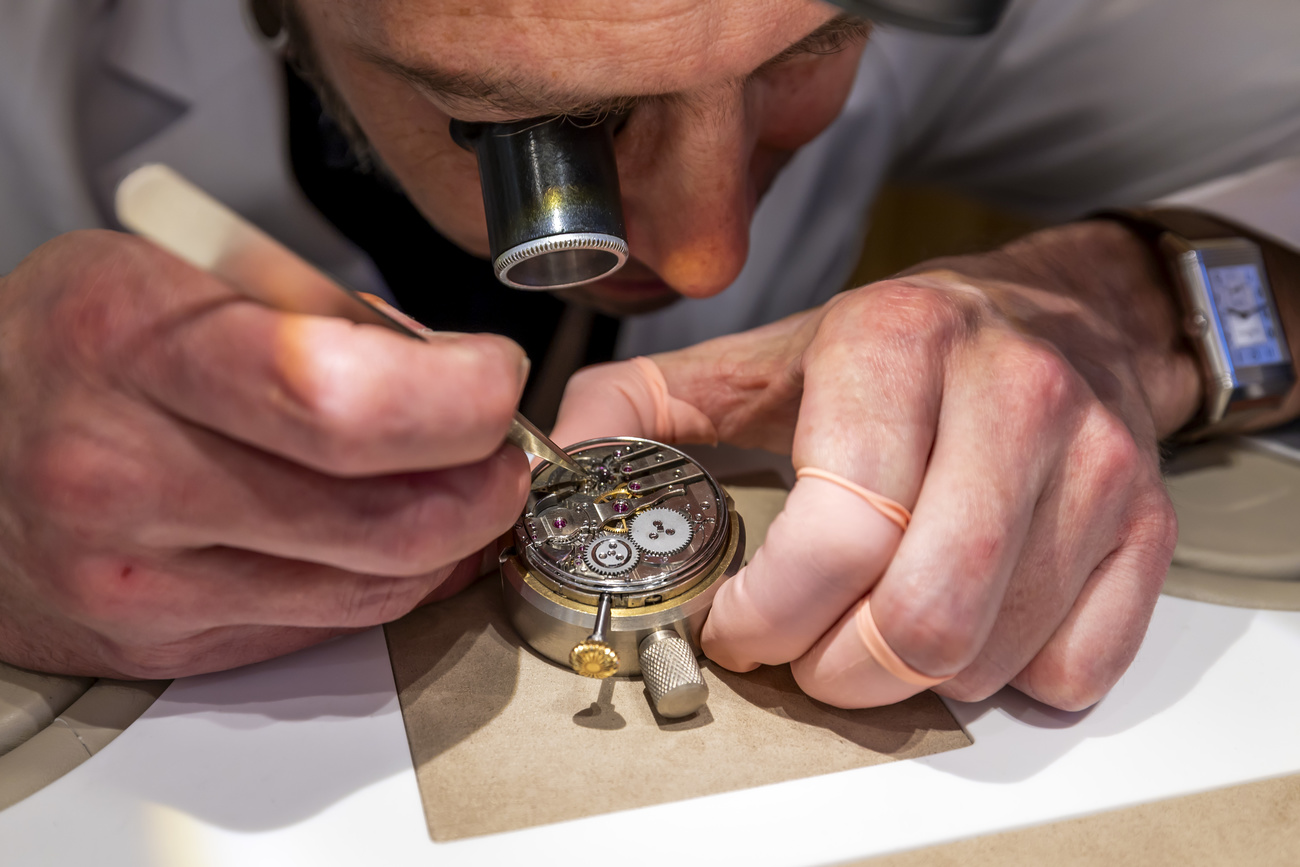It’s Swiss history, but not as we know it

What do a picture of Roger Federer, a huge revolving wheel full of Swiss clichés and a giant banking safe all have in common?
They are all part of a new permanent exhibition called History of Switzerland in the Swiss National Museum in Zurich, which takes a fresh and entertaining look at how a nation came to being.
The show, which fittingly opens its doors on August 1, Swiss National Day, is divided into four thematic parts: migration, religious and intellectual developments, political history and the economy.
“They are what we think are the most important topics in Swiss history today,” exhibition co-curator Pascale Meyer told swissinfo.ch at the media preview on Wednesday.
But the display, housed alongside a comprehensive collections exhibition in the museum’s newly renovated wing, is no traditional chronological one. Each section is self contained and follows its own timeline.
Federer – son of a Swiss and a South African and recent father of two girls – makes his appearance along with other illustrious Swiss residents with foreign roots in the migration section.
Swissness?
What becomes clear through the exhibits is that it is very difficult to define a Swiss. The country has had waves of migrants ever since the Bronze Age and Roman times. Today, Germans make up the new large immigration population.
“We very consciously chose to show that when we speak of Swiss identity, we have to first of all say that these migratory movements have influenced this area and that something like genuine ‘Swissness’ does not exist,” Meyer said.
Visitors are even encouraged to take a fake “naturalisation” test to see if they would pass muster to become Swiss.
But what of Heidi, William Tell and the mountains which represent Switzerland in the minds of many? These clichés, the exhibition says, became popular in the 19th century, when Switzerland was a fledgling nation moving from conflict to consensus politics.
They are represented in a nine-metre high moving “Wheel of Myths”, which like Swiss cheese has small holes in it, containing among other things, a Heidi doll, a cow bell and even a copy of the Swiss Federal Charter. Meyer said that it was both a way of addressing these myths and taking a factual approach.
Revolving clichés
“This is why we put them in the wheel, to say that these myths come time and again and have an effect. All countries have these national myths; Switzerland is not an exception,” she said.
Co-curator Erika Hebeisen said that the eyecatching wheel should serve as a good introduction for those not so familiar with Swiss history.
For example, William Tell is said to have liberated the Confederation from “foreign rulers” and is part of the history of the Confederation’s origins.
This legend – it is still disputed whether Tell really existed – has served to help develop a sense of Swiss national identity from the 15th century and only became myth 400 years later when Switzerland became a nation state.
Other important figures, this time indisputably real, make their appearance in the religious and intellectual development section. This includes Protestant reformers Huldrych Zwingli and his Geneva counterpart John Calvin, whose 500th anniversary is being celebrated this year.
Here atmosphere is used to utmost advantage. “We have a cloister room representing a medieval world, which we try to bring into existence using purple for the church and gold for liturgy. There are cloister sounds, with the choir singing, prayers and bells ringing,” Hebeisen said.
This contrasts with the rather stark and sober room devoted to the reformers.
Rich country
The museum is particularly proud of its Swiss economic history section and it’s actually the first time that the topic has been so thoroughly addressed in an exhibition.
“Switzerland becomes rich abroad” is its title and thus the visitor learns how the once poor rural nation, whose major export was mostly mercenaries, transformed itself into, at one point, the second most industrialised country after Britain.
Realising that it had to rely on trading with abroad, the country built up a food, textile and chemical industry. In the mid 19th century Switzerland exported up to 50 per cent of its production to the United States. Tourism boomed.
Banking also came into the fore. In one of the rooms stands a huge Swiss safe, which has multiple drawers in which people used to deposit precious items and financial documents.
Opening a Swiss safe
“It’s a safe from the Swiss National Bank in 1912 and it’s a symbol of discretion and security which is still linked to the Swiss financial world,” Hebeisen said.
Only in this case, even in this time of attacks on the country’s prized banking secrecy, people are actually allowed to open the drawers – but only to find out more about banking history.
The show’s fresh approach to history certainly makes it come alive. However, the exhibition does not shy away from more difficult periods, such as the anti-foreigner feeling of the post-war years or the criticism of Switzerland when it was found to be storing Nazi era gold in its banks.
At the end of the display, an eye is kept on current affairs, shown most topically through the presence of a packet of Tamiflu, the anti-viral against swine flu, developed by Basel pharmaceutical giant Roche. A reminder that history is still in the making.
Isobel Leybold-Johnson in Zurich, swissinfo.ch
History of Switzerland officially opens on August 1 at the Swiss National Museum, along with a new group exhibition made up of 20 collections showing Swiss crafts and products.
The museum has undergone extensive renovation, and History of Switzerland is hosted in a new permanent exhibition space in the station wing. This covers an area of around 1,200 square metres. Around 1,000 items are on display. The Hall of Fame, which was first used to present Swiss history when the museum opened in 1898, was included in the renovations.
The Swiss National Museum has always held exhibits on Swiss history. But these were not so comprehensive in their coverage and were usually influenced by the thinking of the times. This new display covers Swiss history from pre-history to the present.
There will be an Open Doors day at the Museum on August 1.
This exhibition shows a representative overview of the inventory of the Swiss National Museums. On display is handicraft of the highest quality. With more than 820,000 items the Swiss National Museums have the largest collection covering cultural history and Swiss handicraft.
There are 22 collections in all, often displayed in a modern and surprising way. Among the highlights is the textiles section, showing a catwalk of costumes and dresses through the ages, as well as shoes across the centuries.
Also shown, among other things, are portraits, photos, glassware, ornate sleighs and beautiful altars and altar paintings.

In compliance with the JTI standards
More: SWI swissinfo.ch certified by the Journalism Trust Initiative













You can find an overview of ongoing debates with our journalists here . Please join us!
If you want to start a conversation about a topic raised in this article or want to report factual errors, email us at english@swissinfo.ch.